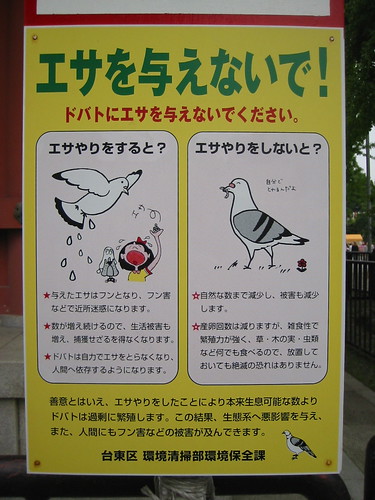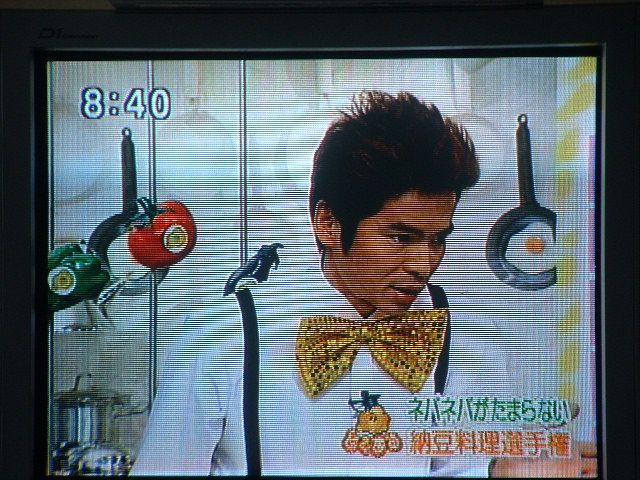Most people are bored by other people's travel monologues, and nothing terribly exciting happened to me in Japan anyway, so I'll try to keep this short. I'll also forsake the usual chronological structure for a thematic approach.
Food
On the whole Japanese cuisine tends towards the bland, which is why the best meal I had the entire trip was Chinese: spicy Ma Po Tofu at one of Iron Chef Chen Kinichi's franchised Szechuan restaurants on the top floor of the Nagoya Takashimaya department store. (Nice view and elegant decor, but not much of a value--$20 for a small bowl of tofu with rice.) I would have liked to try some genuine Japanese sushi but my brother is a finicky eater and restaurants there tend to specialize in one sort of food, so we couldn't find a place where I could get my sushi and he could order something else.
Noodles were prevalent, of course, but again often without much in the way of flavor; I just couldn't appreciate cold udon or soba noodles dipped in soy sauce. As for ramen, we tried Jangara Ramen--recommended in the Lonely Planet book as one of the best ramen joints in all of Tokyo. A tiny, cramped place with only three walls, housed at the bottom of an office building. Some of the Japanese near the entrance shivered in long sleeves from the night breeze, which we found amusing since the temperature was probably only in the mid sixties. The staff didn't speak English (a problem we encountered at most places) but they pulled out some English language menus and we were able to point to what we wanted. Expensive stuff, about ten dollars a bowl, and very different from what we think of as ramen. The noodles were more like straight angel hair pasta than the usual crinkly stuff, and the soup was filled with thick, fatty chunks of pork, shredded vegetables, an unidentifiable paste that I avoided eating, and a brown tea-boiled egg. The atmosphere was lively with young people crammed together at long tables and upbeat J-pop playing on a portable radio. But the pork was really, really stinky--which, according to the book, is the way it's supposed to be…
Some things I liked:
--Unadon (barbequed eel on rice) that I had in a bustling second floor Tokyo restaurant filled with chain-smoking businessmen;
--Inari sushi, desserts made of rice wrapped in pressed sheets of glistening deep-fried tofu;
--The ubiquitous breaded pork cutlets;
--a paper-thin pizza (no exaggeration--it broke when I picked it up) topped with oysters, squid, shrimp, and octopus at a surprisingly cheap Italian place
--onigiri, triangles of seaweed-wrapped rice and shreds of fish served for breakfast.
The basement levels of the big department stores had an amazing selection of foodstuffs, all beautifully packaged and displayed, but also ridiculously expensive--$5 for an apple, $15 for a melon, $30 for a box of cookies. At one store we were amused to see an "International Food Court" section in which was shelved such exotica as Ritz Crackers, Jiff Peanut Butter, and Spam.
Drink
I finally tasted good sake! The stuff I’ve had in the U.S. has been as astringent as rubbing alcohol, but in Japan the better varieties are smooth and flavorful. The food levels of the department stores give out free samples of various items, and at a couple of places my brother and I were plied with little cups of booze. I was also impressed by the Shochu (native Japanese whisky); after five snorts of it (at 10:00 in the morning, no less) I was a bit light-headed. But I ended up buying a bottle of sake for $23.
Beer in vending machines is a great idea. The national brews are nothing special but they're at least better than their mainstream American counterparts. If you're in Tokyo I recommend the Yebisu Beer Museum, which has a inexpensive tasting room at the lower level.
Green tea is served for free at many of the restaurants. Some of the fancier green tea I tasted in the department stores, however, was extremely strong and bitter, and I could tell I was nearing the tea section of the store by the acrid smell.
Vending machines are planted at practically every street corner, probably because Tokyoites have to walk so much, and the soft drink I came to rely on to keep me hydrated is the famous, dubiously-named Pocari Sweat. It's basically a low-cal version of Gatorade.
Women
Some were attractive and some weren't, of course, but I did appreciate the fact that they were almost universally trim--must be all that bland food and walking. There were certain recognizable types: the famous Japanese schoolgirls in variations of British 19th century naval uniforms, office women in dark, conservative jackets and skirts, and, occasionally, matrons in kimonos (a pleasingly anachronistic effect was produced when these last were spotted on subway cars talking into their cell phones).
Servility
"Servility" isn't exactly the word I want to use, but I was impressed by the politeness and helpfulness of service personnel. The fact that they all wear uniforms only adds to the aura of professionalism. It began in the airport; uniformed girls carefully arranged our luggage as it dropped on the carousel, a uniformed man smiled and asked us to watch our step as we neared the end of the moving sidewalk, and uniformed train personnel stood by the ticket vending machines helping people (especially foreigners) get the correct fare into town. The contrast with our arrival back at Chicago-O'Hare could hardly be more stark: the apathetic customs official stamped our entry form in sullen silence, and an abrasive American Airlines agent berated a Japanese man for standing in the wrong line.
One representative anecdote: In Tokyo we happened to arrive at one of the major department stores at opening time. A pair of employees stepped out of the inner glass doors into the lobby and bowed. One of the pair, a young woman in a getup that made her look like a 1960s airline stewardess, spoke some highly formalized words of greeting into a microphone. (My brother, who has a semester of Japanese under his belt, was able to pick up the gist.) Then they bowed a second time and opened the doors. My brother and I entered first and immediately headed for the escalators in the back so as to get to the food section in the basement. As we walked side by side down the long aisle between perfume, makeup, jewelry and accessory counters, flanks of uniformed personnel stood stiffly at attention and bowed as we passed, uttering the standard Japanese welcome "Irashaimase." You don't get that treatment at Wal-Mart.
Crowding
Worse than Hong Kong!
Television
Granted, I don't understand Japanese, and the channel selection in the hotels was undoubtedly limited, but it still seems to me that Japanese television is pretty bad--mostly endless variations on the talk show format. One show, however, was strangely fascinating: Saku Saku. True, it's also a talk show, but only in the surreal, satirical way that "Space Ghost Coast to Coast" is. The interlocutors were a robot muppet whose limp posture and half-shut eyes make him look stoned, chattering raucously without ever moving his mouth or making a gesture, and a young woman with bobbed hair who stared off-camera and occasionally laughed along with the stagehands at the robot's jokes. The conversation was broken up with homemade rock songs and accompanying videos about fast food outlets and Tokyo University. The lack of all but the flimsiest attempts of the girl to interact with the robot, or of the muppeteers to make it seem animated (at one point I even saw a hand reach onscreen and adjust it), gave the show the cheerfully amateurish feel of something like "Wayne's World." Some US channel should dub it and turn it into the next "Iron Chef" or "Most Extreme Elimination Challenge."
Transportation
The subways are clean, punctual, and frequent. Likewise with the trains. The Japanese do take their trains seriously. While we were there the Japan Rail wreck was discussed endlessly on the TV news. I don't know how many times I saw a clip of the JR-West president visiting the homes of one of the victims to prostrate at an altar bearing his image and then apologizing in the most abjectly Asian way before the victim's parents. (Since I returned to the US I've seen that he resigned--which is better than hara-kiri, at least, but it still seems extreme given that the wreck was due to the negligence of the conductor.) Other evidence of the Japanese pride in their train service: the “Tokyo Hands” department store sold a lot of train and subway memorabilia, and the most impressive museum we went to was the Transportation Museum, which had among other things the biggest model train setup I’ve ever seen. (Felix, I'm not sure I would have been able to drag you out of there.)


